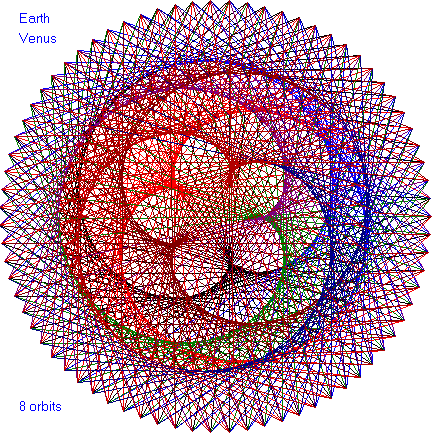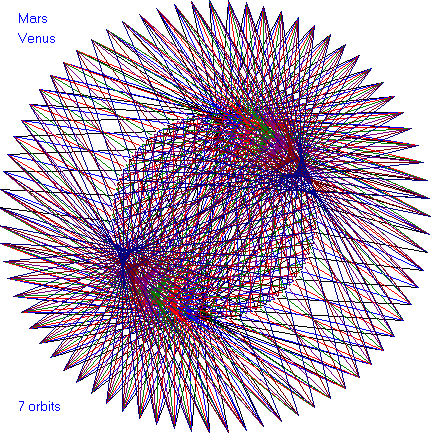 The sketches, each an illustration of a planetary pairing's unique dance rhythm, were created by Howard Arrington using the Ensign Software plotter language, ESPL.
The sketches, each an illustration of a planetary pairing's unique dance rhythm, were created by Howard Arrington using the Ensign Software plotter language, ESPL.
March, 2015
The St.Louis Astronomical Society shares a link to colorful, geometric orbital patterns that capture Dances of the Planets in our solar system.
 The sketches, each an illustration of a planetary pairing's unique dance rhythm, were created by Howard Arrington using the Ensign Software plotter language, ESPL.
The sketches, each an illustration of a planetary pairing's unique dance rhythm, were created by Howard Arrington using the Ensign Software plotter language, ESPL.
"The idea is really quite simple by treating each planet's orbit as a concentric circle whose radius is proportional to the planet's distance from the sun," explains Arrington. "The planets orbit the sun at different rates. For each incremental movement of the outer planet around the circumference, such as at a 5 degree interval, a straight line is then drawn to connect the 2 planets." On the first drawing of the Earth-Venus pair, the outer planet made 8 orbits around the sun. "You can see there are 8 vector lines into each of the incremental draw points around the circumference of the circle." With each orbit of the outer planet, a different color was used for the lines drawn. The pattern that emerges is unique and beautiful, "a function of the harmonic of the orbital speed differences of the two planets," writes Arrington. A link to more planetary dances and the code is below.

Capturing dances of the celestial orbs in artful ways is a human endeavor that can can be traced to ancient times. While we tend to express our strivings with sky-reaching architectural feats, dares and evidence of our culture's advancement, Earth dwellers millenia ago were just as likely to build gigantic structures along the ground: Man-made mounds and causeways spanning great distances, following geometries inspired by the mouvements of celestial objects above vast structures which low-lying remnants still reflect ancient strivings and advancement.
Dr. William Romain uses LiDAR ("light" and "radar") imagery and archaeoastronomic assessment methods to document the celestial alignments of ancient sites. On March 22, Bill Romain will present Ancient Skywatchers of the Eastern Woodlands, at the Cahokia Mounds state Historic Site, and discuss how people who built these mounds were influenced in their designs by studies of the skies. Romain will show that the city of Cahokia was designed using nested squares, a special unit of length, and alignments to the moon. Romain will also explore certain design principles held in common across our region and significant trends through time. Find out more at https://www.illinois.gov/ihpa/news/Pages/Cahokia-Lectures.aspx.
Thank you to Dr. Carol Diaz-Granados at the WUSTL Department of Anthropology for sharing news of the upcoming presentation by Dr. William Romain, and to SLAS for offering a wealth of resources for astronomy enthusiasts in the St.Louis area. The St.Louis Astronomical Society meets for monthly lectures at Washington University in St.Louis, in Room 162 of McDonnell Hall. SLAS regularly hosts star parties at the St.Louis Planetarium and other local venues. Visit http://www.slasonline.org to find out about upcoming SLAS events. Many thanks also go to Ensign Software and Howard Arrington for the inspiring dance captures featured above. View more planetary dances and the code behind the art at http://ensign.editme.com/t43dances.
Enjoyed this story? See also the January 2015 News stories Math Art: Projection of a 4-Dimensional Regular Polytope⇨
— Math news, stories, videos, and interviews by Marie C. Taris, http://www.math.wustl.edu/marietaris/math.html⇨

Contact Us | Home Page
Department of Mathematics | Washington University in St. Louis | One Brookings Drive, St. Louis, MO 63130-4899 |
contact@math.wustl.edu